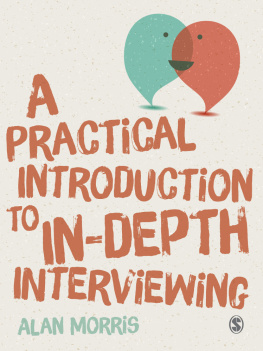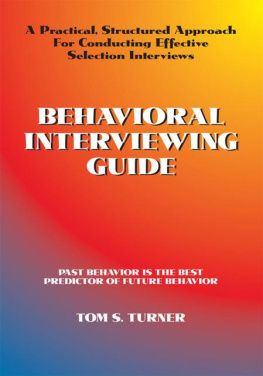LEARNING FROM
STRANGERS
THE ART AND METHOD OF
QUALITATIVE INTERVIEW STUDIES
ROBERT S. WEISS

THE FREE PRESS
Copyright 1994 by Robert S. Weiss
All rights reserved. No part of this book may be reproduced or transmitted in any form or by any means, electronic or mechanical, including photocopying, recording, or by any information storage and retrieval system, without permission in writing from the Publisher.
The Free Press A Division of Simon & Schuster, Inc. 1230 Avenue of the Americas New York, N.Y. 10022
First Free Press Paperback Edition 1995
www.SimonandSchuster.com
Printed in the United States of America
printing number
9 10
Library of Congress Cataloging-in-Publication Data
Weiss, Robert Stuart
Learning from strangers : the art and method of qualitative interview studies / Robert Stuart Weiss.
p. cm.
Includes bibliographical references (p. ) and index.
ISBN 0-684-82312-8
ISBN 0-684-82312-6
ISBN-13: 978-0-6848-2312-6
eISBN-13: 978-1-4391-0698-3
1. Interviewing in sociology.
2. Social surveys. I. Title.
HN29.W42 1994
301.0723dc20 93-24464
CIP
CONTENTS
Approaches to Analysis and Reporting
PREFACE
I conducted my first qualitative interviews while a graduate student at the University of Michigan. I had recently transferred into sociology from a masters program in mathematical statistics and was employed part time by the universitys survey research center at the usual marginally adequate student salary. At the next desk sat another graduate student, who augmented her income on evenings and weekends by conducting qualitative interviews for a commercial firm, Ernest Dichter, Inc. I was intrigued not only by her success in income augmentation but also by the firsthand contact with respondents afforded by her method of doing so. My survey center assignment, analyzing sociometric data, brought with it no such firsthand contact. I asked whether the Dichter firm could use another interviewer, learned that it could, and started in.
Ernest Dichter, a Viennese refugee, was retained by American manufacturers and advertisers to tell them why people bought or failed to buy particular products. He called his data-gathering approach depth interviewing, probably to suggest that it dredged up its findings from respondents unconscious, where their buying decisions were made unbeknownst to themselves. One of Dichters more widely reported observations was that people saw prunes as representations of old age. He advised prune packers to put their products in a sunshine jar and, in their advertising, to link prunes with children.
I didnt conduct interviews for the prune study, but I did for studies of fiberglass curtains, brands of scotch, and a correspondence school that promised its students it would turn them into artists. Once I received my graduate degree, I ended my work with the Dichter firm to concentrate on what was then my full-time employment, the collection and analysis of survey data. However, I continued to use qualitative interviewing for pilot studies and other small-scale studies. Gradually, I became convinced that the qualitative approach, while quite different from that of survey research, was preferable for some problems. I was particularly struck by the density of information provided by qualitative interview studies and by their usefulness for understanding the complexities of respondents experiences.
Over the years I learned more about how to do qualitative interview research from many friends, colleagues, and teachers: Carol Kaye, Arlene Daniels, Ira Glick, Peter Marris, Lisa Peattie, Lee Rainwater, Martin Rein, and, through his publications as well as personal contact, Anselm Strauss. Most important for me was Everett Hughes, who brought with him to the Brandeis department of sociology, of which I was then a member, the Chicago Schools commitment to firsthand learning about people and their lives. I was the beneficiary of a long tutorial with him under the guise of acting as his co-instructor. I have also had the good fortune to work as a junior colleague with Margaret Mead and David Riesman: with the former on only a few occasions, with the latter for many years.
Despite all this instruction, much of what I have learned about qualitative interview studies has been a product of experience, of trial and errorrather a lot of errorand trial again. Each of the qualitative interview studies I have doneand at this point there have been many, including studies of marital separation, single parenting, bereavement, and the management of work stresshas been an exploration of method as well as of substance.
I have on several occasions been responsible for teaching others to interview or to conduct interview studies. With Everett Hughes I helped establish the field training program in the Brandeis sociology department; more recently, I offered a qualitative interviewing course at the University of Massachusetts in Boston. I have also demonstrated the approach for colleagues with whom I have worked, and I have supervised Ph.D. theses based on qualitative interviews.
This book came about partly as a consequence of my offering workshops on qualitative interview studies at two annual conferences of the American Sociological Association. Those workshops convinced me that a guide to the method would be useful to people in my field and, very likely, in other fields as well.
In this book I try to take the reader from conceptualization of a research project using qualitative interviewing as its method to production of its report. I try to be candid about the problems of this kind of research, but I hope my openness does not obscure my belief in the methods importance for the social sciences. Some issues can be investigated in no other way. I also believe that every investigator in the social sciences should know how to conduct a qualitative interview, just as he or she should be able to interpret a statistical table. Qualitative interviewing is a fundamental method for learning about the experience of others.
Many people have helped me with this book. I want to thank Lisa Peattie for many clarifying discussions of qualitative interview studies, Mark Kramer for his insights into the principles of nonfiction study and writing, and the other friends and colleagues who contributed ideas, observations, and suggestions: Deborah Belle, Arlene Daniels, Uta Gerhardt, David Jacobson, Marie Killilea, Gina Prenowitz, Martin Rein, and Shulamit Reinharz. Erwin Glikes, who was the books editor and publisher, died not long after the books publication. His enthusiasm encouraged me to write the book and his editorial skill helped shape it. I remain grateful to him. Mary Coffey and John Drabik, fellow members of the University of Massachusetts Work and Family Research Unit, contributed to the books production and cheered it on. My greatest indebtedness, as always, is to my wife, Joan Hill Weiss.
Chapter 1
INTRODUCTION
WHY WE INTERVIEW
Interviewing gives us access to the observations of others. Through interviewing we can learn about places we have not been and could not go and about settings in which we have not lived. If we have the right informants, we can learn about the quality of neighborhoods or what happens in families or how organizations set their goals. Interviewing can inform us about the nature of social life. We can learn about the work of occupations and how people fashion careers, about cultures and the values they sponsor, and about the challenges people confront as they lead their lives.








